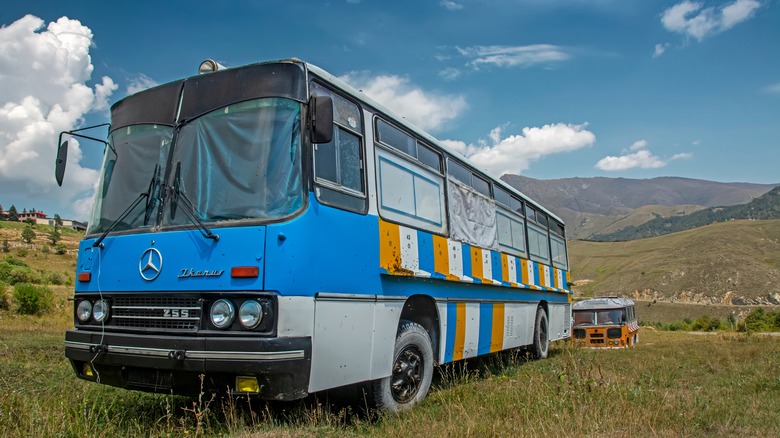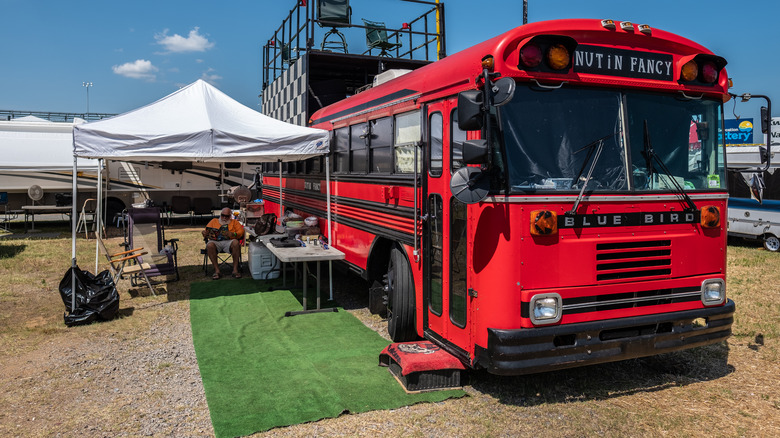How Much Does It Cost To Convert A Bus Into A Tiny Home?
Recently, a new trend has been floating around for homeowners who are searching for an exciting change to their routine life. This trend revolves around homeowners selling their homes and investing in old buses, which they remodel into tiny, mobile homes. From there, these new converted bus owners travel around the world full-time while working virtually from the comfort of their newly created tiny house on wheels.
When choosing a vehicle to make your tiny mobile home, Storey states that school buses are the most commonly chosen vehicle due to their space, durability, and reliability. A school bus is designed to protect the lives of young students as they are transported to and from school, and what vehicle is safer, more durable, and more reliable than one designed specifically for children? Used school buses are also known for being relatively cheap in price. USA Today states that an average used school bus costs as little as $3,500. To fix up an old school bus into the mobile home you desire could cost around $10,000 on top of the price of the bus. To put this all into perspective, RVs cost approximately $47,500, over double the price you would spend to create your own tiny mobile home out of an old school bus. If this piques your interest, let's dive deeper into the conversion process and see what it takes to make your own tiny home on wheels.
Factors for cost
When breaking down the costs that go into converting a bus into a tiny home, all elements of a home must be accounted for. The first purchase would be for the vehicle itself, which USA Today mentions averages around $3,500. Still, one must add insulation, flooring, electricity, plumbing, and more to ensure all the necessities of a stationary home are included.
Insulation
Once the original interior of the bus has been removed, the first thing that must be added to your tiny home is insulation. Insulation is an important factor to add to your home, especially a converted bus because buses are made out of metal, which attracts and loses heat very quickly. For this, The Tiny Life states to expect to pay between $0.50 and $3.65 per square foot and about $0.50 extra to add a finished material on top of the insulation.
Flooring
When it comes to flooring, you want to pick a type of flooring that will last the longest but is also relatively lightweight to prevent it from affecting the rate at which you can travel. Depending on the material you choose, The Tiny Life states that flooring can cost anywhere between $2.75 and $6.80 per square foot.
Electricity
There are many options for electricity within your tiny, converted home. Most people converting school buses to homes choose to equip their tiny mobile homes with solar-powered electricity. The cost of using solar energy to power your home ranges depending on if you have a battery to back up your solar energy. With the battery, you're looking at $2 to $4 per watt. Without a battery, it will cost an average of $2 per watt. When adding in the breaker box, wiring, fuse breaker, and other important electrical elements, expect to pay $1,000 to $3,000 for electricity installation in your home.
Plumbing
The cost of plumbing widely varies depending on your desires and what you are comfortable with. Compostable toilets are available as a way to save on costs of plumbing. Still, there are also several different types of water tanks you can install in your home that allow for various water needs, whether it be for your bathroom or your kitchen. For water tanks, expect to pay around $5,000 for both the tank and its connections, per The Tiny Life.
Style
Although this is not a necessity for your tiny home, you may want to style your home with various colors and furniture to bring your personal style and a sense of comfort to the home. This can easily be done by purchasing or ordering furniture and decorations that best fit your style and price range. When it comes to the exterior portions of your converted home, there are a couple of different painting options to change the original color of the vehicle. To touch up the outside of your tiny mobile home, The Tiny Life recommends expecting to pay either $1,800 for a truck bed liner spray paint or $300 to $400 for a regular automotive paint, which is recommended for exterior uses on your vehicle.
Additional costs
When taking your home on the road, there are also extra costs and fees you need to be aware of that factor into your total cost of living in your converted bus home.
Gas
Especially if you plan on traveling frequently with your bus home, you must account for the gas it takes to get from one place to another. Depending on the size and weight of your converted home, you can expect to have between 6 and 12 MPG, according to Trail and Summit. When it comes to cost, you can expect to pay around $150 each time you fill your tank, although that price will vary based on the size of your bus, your location, and the current gas prices.
Parking fees
Whether moving between locations or searching for a more permanent position to park your home, your home must be parked eventually. Depending on the location and type of parking area you choose, you may be paying upward of a few hundred dollars each month for parking. However, be aware that although most RV parks allow converted bus homes, some may be stricter with the mobile home vehicles they allow on their lots. Before mapping out places to reside throughout your travels, ensure you are prepared to pay for parking for your converted mobile home, per Camper Report.
Maintenance
Regular maintenance for your bus home is also an important factor in your costs for mobile living. The maintenance required for converted buses depends on a variety of factors. Regular yearly maintenance should not cost more than $2,000, which includes oil changes, fuel filters, and other elements of the vehicle and house that need to be regularly changed. Skoolie Livin, however, states that if your converted bus house needs any type of major repair, it could cost $5,000 or more.
Types of buses to convert into home
Paved to Pines states that when it comes to picking a bus to use for your converted home, the type and size highly affect the layout and alterations that can be done to your future mobile home.
Dog-nosed vs. flat-nosed buses
The two main types of buses are dog-nosed buses and flat-nosed buses. Dog-nosed buses, also known as conventional buses, have an extended hood at the front of the bus. Flat-nose buses, which can also be called transit buses, are completely flat where the dog-nosed buses stick out. When choosing between these two types of buses, understand that the dog-nose bus allows for less conversion space and will always carry that distinct conventional bus look despite the conversion process the bus has undergone. The flat-nose bus can be discrete and blend in with traditional campers and also allow for more space that can be converted into a home, explains Paved to Pines.
Bus sizes
The size of the bus also matters when picking the vehicle that will house your new home. The amount of space you want and need will determine what size bus you should convert. The three main sizes of buses include short buses, which range between 20 and 25 feet long, mid-size buses, which range between 25 and 35 feet long, and full-length buses, which range between 35 and 40 feet long. Although a long bus makes for more convertible space, the longer the bus, the fewer available mechanics that can help you fix damage or perform maintenance on your vehicle, according to Paved to Pines. Depending on the space you find comfortable and the confidence you have driving and performing maintenance on the vehicle, you will be able to find the right fit bus for you.
Benefits of living in a converted bus home
One of the biggest reasons people are committed to converting and moving into a small bus home is for the freedom. Freedom Residence mentions that living in a converted bus brings financial, geographical, and many more freedoms that any stationary homeowner would never get to experience. Opposed to other types of lifestyles and mobile living options, living in a converted bus home certainly comes with a variety of other benefits, as well.
Cheap and customizable
RVs usually cost around $47,500 depending on the condition, per USA Today. A used school bus and all the conversions it must undergo to become a home tends to cost less, or at the high end, around the same amount as an RV. When building your own mobile home out of a bus, you can also customize it with elements you find most comfortable, making it feel more like home. This allows you to travel in conditions you find most comfortable at a customizable and affordable price.
No property tax
Moving into a converted bus home and taking your life onto the road frees you from the extra costs you would have to pay when living in a stationary house, for example, property taxes. Property taxes occur as you purchase homes from the real estate market. Living a nomadic life frees you from the real estate market and the expensive taxes that come with it.
Living wherever you please
One of the greatest benefits of living in a converted bus home is the ability to move your house whenever to wherever you please. Whether you need a change of scenery, want to explore a different area, or don't like the people you live around, you can simply fire up your bus home and take it anywhere you wish to go without the hassle that goes into moving stationary homes.
What it's really like living in a converted bus home
Before jumping headfirst into a life on the road, you might want to know what it's really like living and traveling in a converted bus. Although there are plenty of benefits to living a converted bus life, We Got School shares a variety of realities one must face when committing to a life on the road.
No permanent address
Unless you plan on living a stationary life in your converted bus home, your address will continually change as you travel to new places. Although this may not seem like a big deal, little things that are simple with a permanent address, like ordering from online stores, become tasks that need to be planned and coordinated.
Ever-changing lifestyle
When living a stationary life, most people fall into a routine. This routine usually involves work, school, errands, and planned activities. Living on the road, however, evokes a sporadic lifestyle. When you're always traveling to new places, things come up unexpectedly, and you must learn to adjust your schedule and deal with events as they arise. These events can be exciting or stressful. Nothing on the road is certain.
Less privacy
When you travel and live within small quarters with another person, there is less privacy from each other. But when you're constantly on the road and transitioning between campgrounds and parking spaces, your privacy from the public also decreases. Especially if you have lived your entire life on the private, stationary property, this can be a major shift that could take some time to adjust to.
It's not a vacation
Traveling full-time in your converted bus home may seem like a vacation that never ends, but it is quite the opposite. When bringing your home on the road, there is still consistent maintenance and chores that need to be done throughout your travels. Living on the road also doesn't excuse you from working to maintain your lifestyle and the financial responsibilities you still have.





